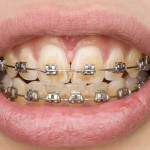
The incidence of Class II division 2 malocclusion is around 10% in the UK and is characterised by characterised by retroclined upper front teeth and an increased overbite. Occasionally the overbite may be deep enough to cause trauma to soft tissues. A range of orthodontic appliances have been used to correct class II division 2 malocclusion and in severe case combined surgery and orthodontic approaches are used.
The aim of this Cochrane review was to establish whether orthodontic treatment that does not involve extraction of permanent teeth produces a result that is any different from no orthodontic treatment or orthodontic treatment involving extraction of permanent teeth, in children with a Class II division 2 malocclusion.
Methods
Searches were conducted in the Cochrane Oral Health’s Trials Register, the Cochrane Central Register of Controlled Trials (CENTRAL) MEDLINE, Embase, the US National Institutes of Health Ongoing Trials Register and the World Health Organization International Clinical Trials Registry Platform.
Randomised controlled trials (RCTs) and controlled clinical trials (CCTs) of orthodontic treatments to correct deep bite and retroclined upper front teeth in children were considered. Combined orthodontic treatment and surgery approaches were not considered. The primary outcome was the dento-occlusal results of treatment measures using the PAR index. Standard Cochrane methodological approaches were planned.
Results
No RCTs or CCTs assessing the treatment of Class II division 2 malocclusion in children were identified.
Conclusions
The authors concluded: –
It is not possible to provide any evidence-based guidance to recommend or discourage any type of orthodontic treatment to correct Class II division 2 malocclusion in children. Trials should be conducted to evaluate the best management of Class II division 2 malocclusion.
Comments
This Cochrane review updates the previous version published in 2006. Given the increasing emphasis on evidence-based practice in recent years if is disappointing that no RCTS of CCTs could be included in this review. In the implications for research section the authors highlight some potential reasons for this including low prevalence, ethical issues and recruitment issues. However, given that amount of government funding spent on orthodontic treatment in countries like the UK surely there is a need to ensure that this is being spent of the best available treatments and this can only be done if high quality research being conducted to provide this information.
Links
Primary paper
Millett DT, Cunningham SJ, O’Brien KD, Benson PE, de Oliveira CM. Orthodontic treatment for deep bite and retroclined upper front teeth in children. Cochrane Database of Systematic Reviews 2017, Issue 10. Art. No.: CD005972. DOI: 10.1002/14651858.CD005972.pub3.
Other references
Cochrane Oral Health Group Blog – No evidence from RCTs on effectiveness of orthodontic treatment for deep bite and retroclined teeth
Dental Elf – 9th Dec 2015
Class II malocclusion- fixed or removable functional appliances?
Dental Elf – 16th Dec 2015
Class II malocclusion- premolar extraction and soft tissue profile
